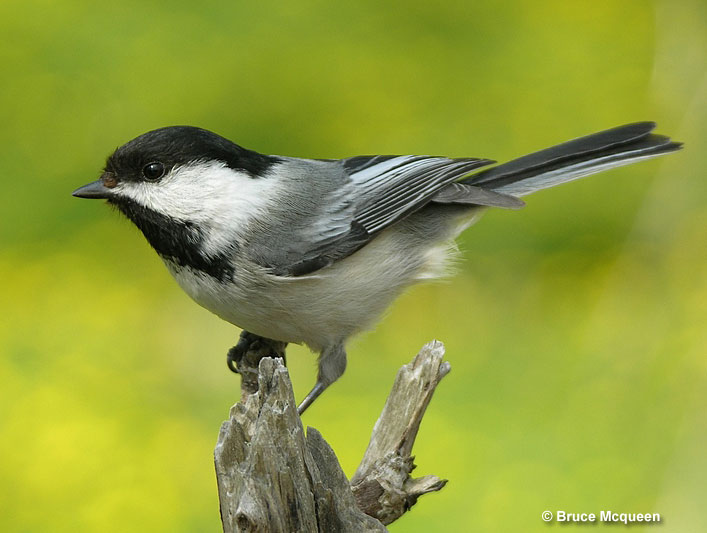
Massachusetts is a small, densely populated state bordered by the Atlantic Ocean and other New England states. Home to 7 million people, the Commonwealth of Massachusetts boasts 10,565 square miles of beautiful coastline, ocean, lakes, and cranberry bogs. It also has woodlands, fresh lobsters, and Boston, its historic capital city. Another feature of this state is a surprisingly large bird list of 510 species.
The bird list for Massachusetts is boosted by a variety of habitats including forest, marshes, and coastal areas. Thanks to these and other factors, many rarities have also visited the state.
The birds of Massachusetts include three extinct species, one extirpated species, and more than 180 rare and vagrant bird species. The official bird list also has several hawks in Massachusetts and the Massachusetts state bird, the adorable Black-capped Chickadee.
In this article, you’ll find all the necessary birding information about Massachusetts – from the most common birds to hawks, and owls.
On this page
Most Common Birds of Massachusetts
According to North America Breeding Birds Survey in 2021, these are popular birds in Massachusetts. We’ve added Massachusetts’s most popular hawks and owls to this list as well.
American Robin
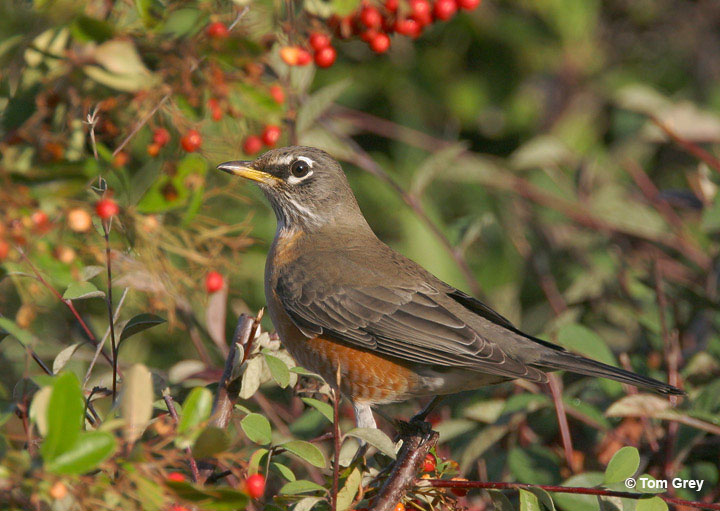
© Tom Grey
The American Robin is a big thrush with yellow on the beak, handsome orange-red on the breast and belly, and a dark head. It has a bit of white on the face, throat, and belly, and the back and wings are gray. The long tail is dark gray or black with white in the outer tail feathers.
Female robins resemble males but are browner, not as colorful, and have some white marking below. Juvenile robins have spotting and pale orange on the breast and belly.
The American Robin picks worms and insects from lawns and other, open grassy spots during the summer. In winter, large flocks of robins move around in search of berries and other small fruits that they feed on.
Contrary to popular belief, the American Robin only migrates short distances for the winter and, at this time of year, can usually be found in big parks and in rural areas.
Gray Catbird
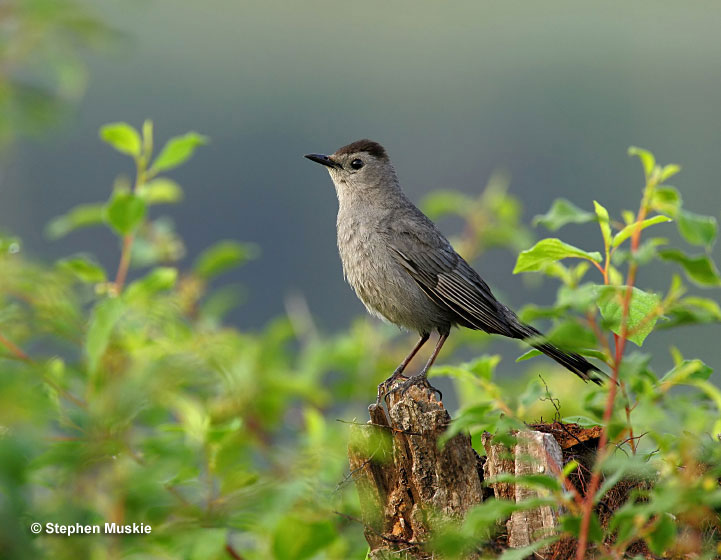
The Gray Catbird is a slender, thrush-sized relative of the mockingbird with gray plumage, a sharp black cap, and reddish under the tail. Both sexes look the same, have a beady black eye on a gray face, longish tail, and a slender bill. It uses its beak to pick berries and insects from bushes and other low vegetation.
Gray Catbirds get their name from their cat-like, nasal “reaah” call. This vocalization is often heard from dense thickets and other low vegetation where these dark gray birds love to skulk and hide.
Catbirds also have a complex song of mixed and abrupt phrases often sung from the top of a bush. In Massachusetts, this svelte bird is a common summer species in woodlands and areas with thick second growth.
In fall, many migrate to warmer climes as far as northern Colombia, but some also stay for the winter, especially in coastal areas.
Chipping Sparrow
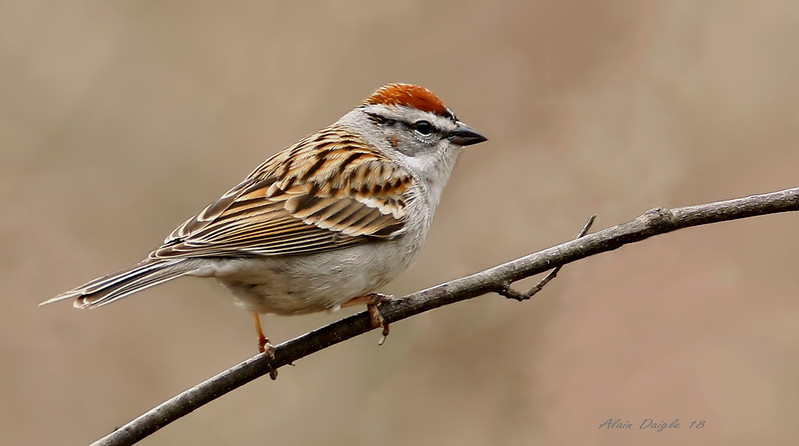
© Alain Daigle
The Chipping Sparrow is a small, slender sparrow with a slight, conical beak, rufous on the cap, and a narrow black line through the eyes.
It also has narrow white eye crescents, a pale eyebrow, and gray on the side of the neck and face. Its underparts, lower back, and rump are gray, and the rest of the back is brown with black streaking.
This sparrow has a longish, pale brown, slightly forked tail, and rounded wings with black markings and two pale wing bars. In fall and winter, the bill of the Chipping Sparrow is pale, and the bird has more brown on the head.
The Chipping Sparrow is commonly seen in open habitats with conifers, especially big, open parks where it eats insects and seeds picked from the ground.
The dry trilling song of this species can be heard in spring and summer in most parts of the state. In the winter, it forms flocks that migrate to Florida, Mexico, and southern California.
Red-eyed Vireo
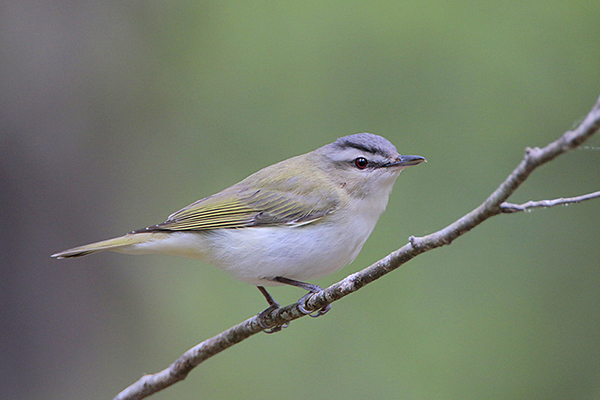
Photograph © Greg Lavaty.
The Red-eyed Vireo is a pale, small bird that is olive above and white below with some pale brown on the cheeks.
Males and females look the same and have a gray cap with a narrow black border, a pale eyebrow over reddish eyes, and a dark line through the eyes. Young birds look just like adults but have brown eyes.
The Red-eyed Vireo uses it gray bill with a small, hooked tip to pick caterpillars and other insects from the foliage of deciduous trees in every part of Massachusetts.
It forages in wooded areas by carefully moving through trees and inspecting leaves and twigs for hidden insects. The constant song of this bird is heard in woodlands from May to July and sounds like, “See me? Up here! Here I am…Up here!”
Red-eyed Vireos leave the state in fall to migrate to and winter in tropical habitats in the Amazon rainforest.
European Starling
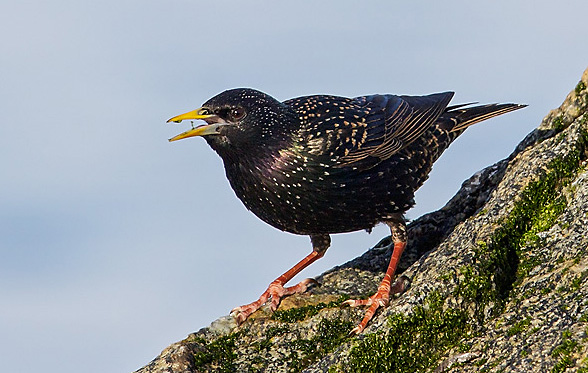
Photograph © Glenn Bartley.
The European Starling is a rotund bird around the same size as a thrush or small blackbird. Adult males in summer have sharp, yellow bills, black plumage with iridescent purple and green highlights, and pale spots on the belly, back, and under its short tail.
Female starlings in summer are similar to males but have more spotting and less iridescence. Juveniles are very plain, gray birds with some white on the throat. Adult starlings in winter have more spots, reddish markings in the wings, and more gray on the head.
This introduced species does very well in farmlands, parks, urban areas, and other places with cavities for nesting and enough food to eat. It uses its sharp beak to pick seeds, grain, insects, fruits, and other bits of food from the ground and usually occurs in groups.
In winter, European Starlings use their long wings to fly together in large, coordinated flocks called, “murmurations”.
Red-winged Blackbird
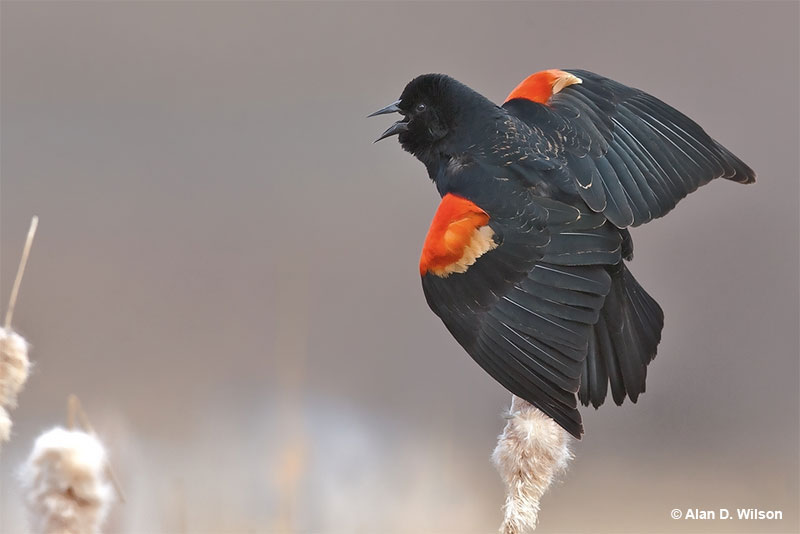
The Red-winged Blackbird is a bit smaller than an American Robin, has a black, pointed beak, black eye, and a longish tail with a rounded tip.
Male Red-winged Blackbirds have a bright red shoulder bordered with a narrow yellow and white border. The rest of the bird is entirely black, legs and feet included.
The female Red-winged Blackbird looks very different and has upperparts with brown mottling and white streaking, and brown-gray underparts with white streaks. Females also have a brown-yellow throat and eyebrow.
In Massachusetts, Red-winged Blackbirds eat various seeds and grain, especially corn, and feed on insects. During the summer months, the flashy red in the wings of male birds is a common sight in ditches and marshes with cattails, brushy fields, and large parks.
Their “kon-ker-ee!” song is also frequently heard, especially in early spring. In the winter, large numbers of Red-winged Blackbirds flock together to feed in farm fields and other open habitats.
Northern Cardinal

© Elaine R. Wilson
The Northern Cardinal is a beautiful, finch-like bird with a showy crest and big, orange-red, conical beak. Male Northern Cardinals are bright red with jet black on throat and face, and have duller red coloration on the wings, tail, and back.
Females are buff, grayish, and brown with some red in the tail, wings, and crest. They also have less black on the head. When Northern Cardinals use their short wings to fly, the tail looks long and has a rounded tip.
The Northern Cardinal uses its strong beak to eat crack open seeds and eat fruits of Sumac, Grape, Dogwood, and many other plant species. In the spring and summer months, this species also feeds on buds and a variety of insects that it picks from leaves in short trees and bushes.
In Massachusetts, the lovely “what-cheer!” whistles of the Northern Cardinal are a regular part of the soundscape in parks, gardens, and other edge habitats.
Tufted Titmouse
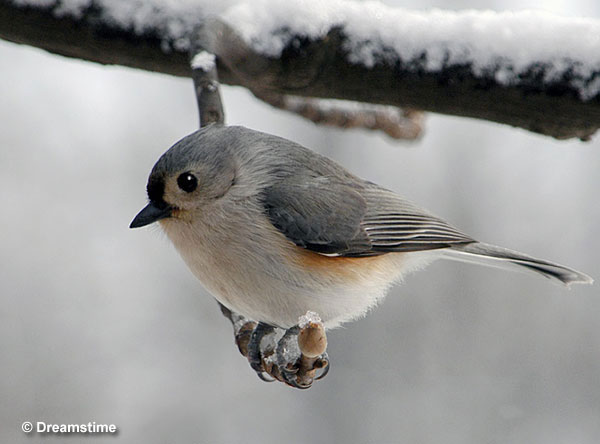
The Tufted Titmouse is a small, sparrow-sized, pale bird with a perky crest. Both sexes have plain, blue-gray upperparts, black above a short black bill, white face and underparts, and some white edging in the wings. The flanks are brushed with peach, and the white face punctuated with a small black eye accentuates an already cute appearance.
This friendly relative of the Massachusetts state bird forages for insects and seeds by using its bill to glean food from foliage and bark.
It breaks open seeds with its bill while holding the seed with its foot, and also picks up acorns from roads where they have been broken open by cars. The Tufted Titmouse is regular at feeders and often forages in flocks with chickadees and other birds.
In Massachusetts, the whistled “peter peter peter” calls of the Tufted Titmouse are commonly heard in oak woodlands, parks, and large gardens throughout the state.
House Sparrow
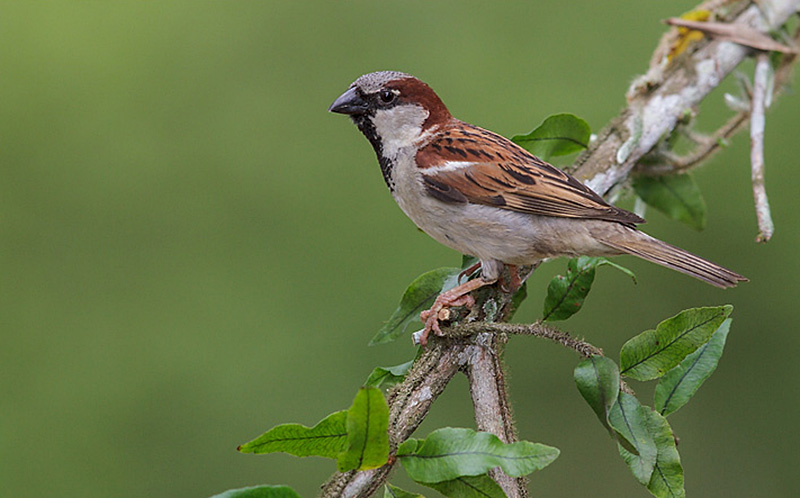
House Sparrow (Passer domesticus) perched on a branch in the Atlantic rainforest of southeast Brazil.
The House Sparrow is a brown and gray songbird with a strong, finch-like beak. Males have black on the throat and face, a black bill, gray on the crown, rufous-brown on the side of the head and back, and a white or pale gray face.
It also has buff and dark streaks on a brown back, a gray rump, and a grayish-brown tail. The wings are short, rounded, brown with dark edging, and have white shoulders.
The female House Sparrow is a plainer bird lacking a strong head pattern, has a pale bill, buff above the eye, dark line through the eyes, and brown on the crown.
This familiar, introduced species feeds on seeds, grain, insects, and other bits of food, including garbage. The House Sparrow has evolved to coexist with people and can be very common on farms and in parks.
In Massachusetts, House Sparrows pick food from the ground, can dominate bird feeders, and group together in small flocks, especially during the winter months.
Song Sparrow
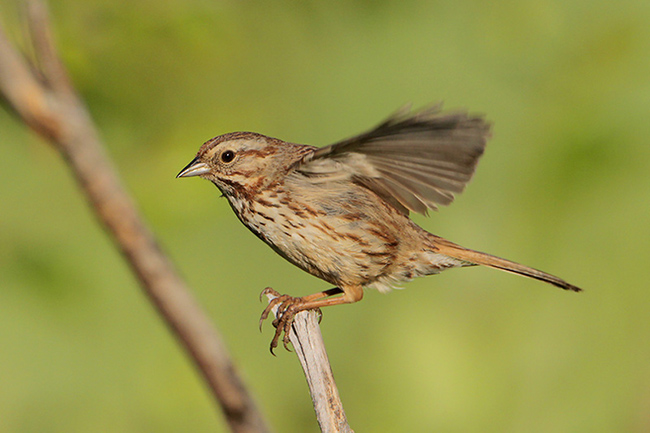
The Song Sparrow is a small bird with a conical, rather slender bill. Both sexes resemble each other and have heads patterned in brown and gray, thin, buff eyerings, and yellow-brown “moustache” marks edged with a dark brown line.
This sparrow species is also pale underneath with a prominent brown spot on the breast, and dark brown streaking on the flanks. They are mottled brown above with dark streaking, and the brown tail of the Song Sparrow is fairly long and slightly rounded. This species also has short, brown wings with a pair of white wing bars.
Song Sparrows forage for insects and seeds in edge habitats like brush piles and second growth throughout the state of Massachusetts.
They pick food from the ground and low vegetation with their bill, and also visit feeders where they may take seed from the ground instead of perching on the feeder. The bright and friendly song of the male Song Sparrow is frequently heard during spring and summer.
Ovenbird
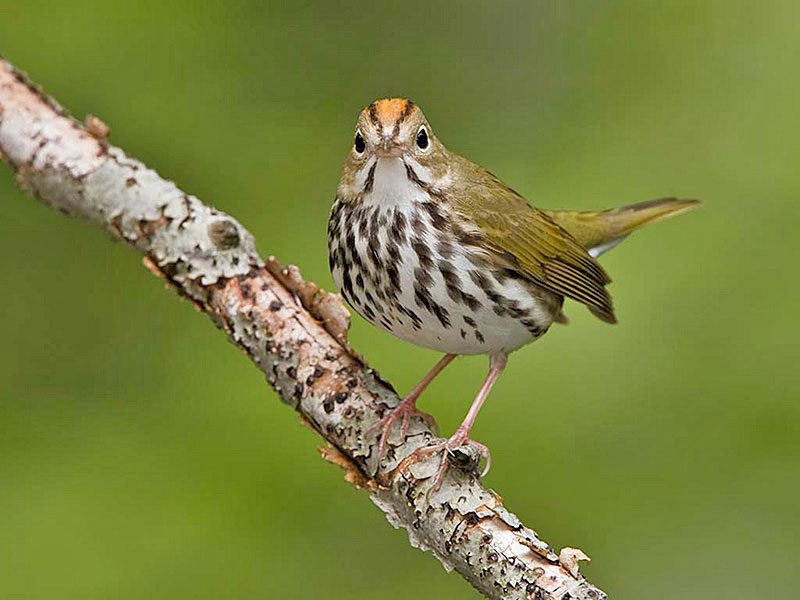 The Ovenbird is a warbler species that prefers to walk on the ground. This small bird is olive above and white below with dark streaks on the breast and a dark line on each side of the throat.
The Ovenbird is a warbler species that prefers to walk on the ground. This small bird is olive above and white below with dark streaks on the breast and a dark line on each side of the throat.
Both sexes and young birds look the same and have a prominent white eyering, and an orange stripe bordered with black on the top of the head. Ovenbirds have short and sharp, pale beaks, pinkish legs, and white underparts with a short black line on each side of the throat.
This species prefers wet second-growth and mature woodlands. It eats a variety of small insects and forages for them while walking along the forest floor and using its beak to snatch food items from the ground and low vegetation. In its search for food items, the Ovenbird can turn over and look under leaves, and struts with the tail cocked up. During summer, the loud and distinctive song is commonly heard in forest and sounds like “teacher, teacher, TEACHER!”. Ovenbirds migrate to Caribbean islands, southern Mexico, and Central America by fall.
Black-capped Chickadee
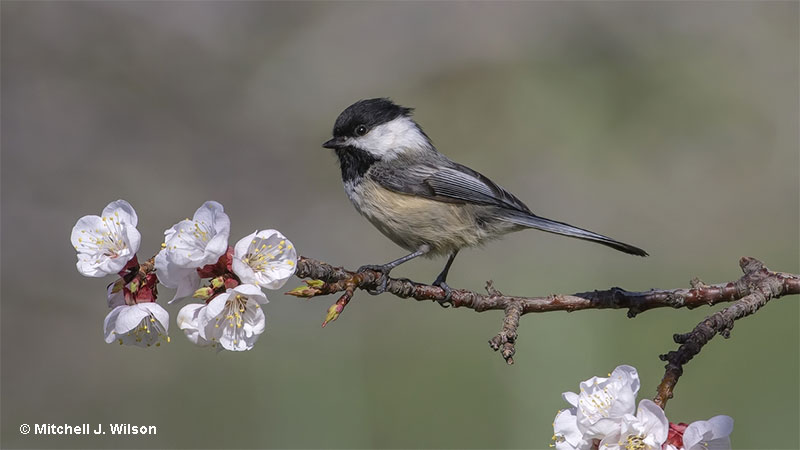
© Mitchell J. Wilson
As mentioned before, Black-capped Chickadee is the Massachusetts state bird. This small and friendly bird species is commonly encountered in woodlands, parks, gardens throughout the state, and often visits feeders.
Both sexes look similar, have a jet-black cap, black throat patch, and a white face and side of the neck. These little birds have short black bills, are pale brown-gray above, white and buff below, and have wings with some white edging.
Black-capped Chickadees have strong feet perfect for holding onto twigs as they hang upside down or sideways so they can reach hidden insects.
The Black-capped Chickadee forages in flocks as it eats berries, seeds, caterpillars, and small bugs, and often visit feeders to feed on suet and seeds.
Chickadees use their bills to pick insects and spiders from nooks and crannies in bark, and can also fly from a perch to catch insects in flight. The nasal and noticeable calls of this bird are often heard and sounds like, “dee dee dee” and a whistled “fee-bee”.
American Crow
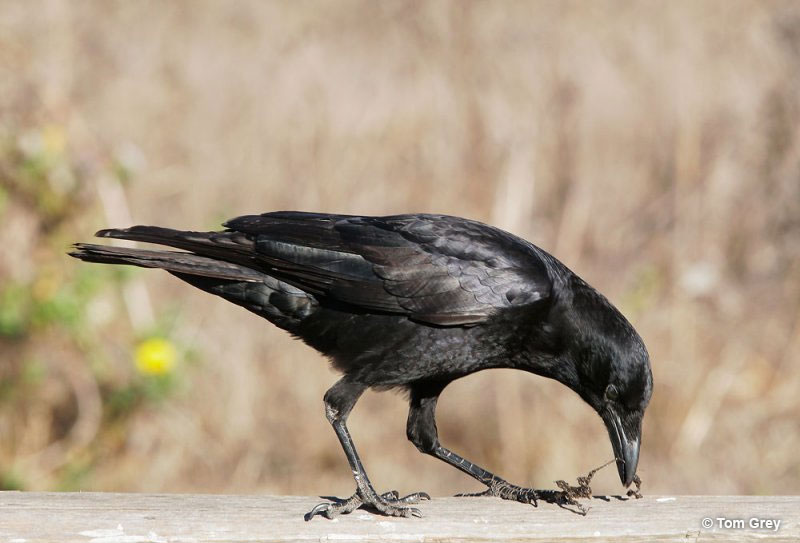
© Tom Grey
The American Crow is big, dark bird easily seen in habitats throughout the state of Massachusetts. The size and loud “Caw! Caw! Caw!” calls make the American Crow a hard species to miss.
When we take a closer look, we see that the black plumage of this common bird has deep dark blue highlights, and that it has feathers on top of part of its stout, strong bill.
Both sexes look the same and have strong legs and feet suitable for perching on branches and walking on the ground.
American Crows are very social and often seen in groups that forage for everything from fruit and nuts to bird eggs, nestlings, carrion, and garbage.
They can forage in all sorts of places, including in wetlands, woods, open fields, parks, and cities, and use their long wings to fly to and from roosting sites.
Crows also give excited alarm calls when spotting a predator and can inadvertently reveal the presence of hidden owls to birders.
Common Grackle
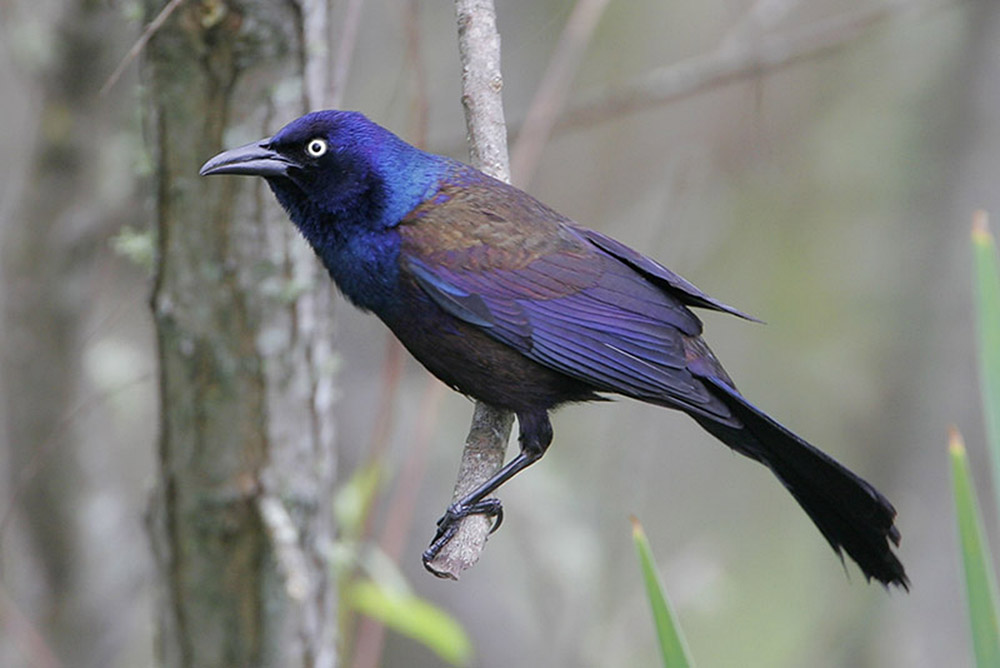
Photograph © Greg Lavaty.
The Common Grackle is a fair-sized blackbird species with a long tail and a pale eye. Both male and female Common Grackles are black with purple, bronze, and dark blue iridescence.
This species has a strong bill, sharp-tipped bill, long, strong legs and feet for perching and plenty of walking, and medium-length wings.
Females look very similar to males but aren’t as iridescent and have shorter tails, whereas the tail of the male Common Grackles has a wedge-shaped tip that is especially apparent in flight.
This blackbird species is well adapted to living near people and feeds on a wide variety of items including seeds, grain, fruit, insects, and other small animals.
It usually forages on the ground, picking food items out of the grass and dirt with its pointed bill, and forms flocks with other Common Grackles, Starlings, and other blackbirds. In the winter, flocks of Common Grackles can number in the thousands.
Mourning Dove
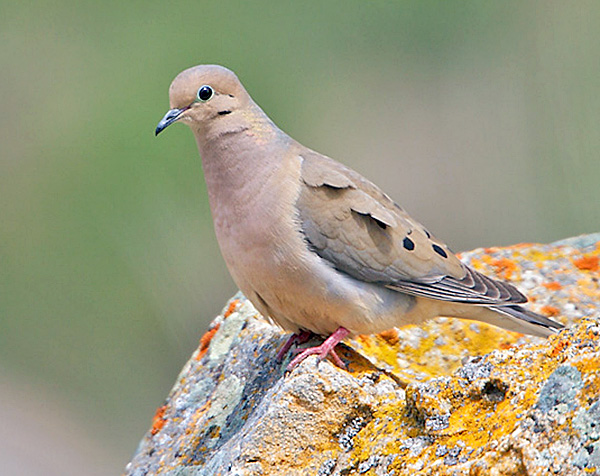
Photograph © Greg Lavaty.
The Mourning Dove is plumaged in soft brown and gray colors, and has a long, pointed tail. This species has a small, slender, dark beak, a gray eyering, and short, reddish legs and feet.
This dove has gray on the rump and tail, and white, buff and light brown in the rest of its plumage. There are white tips on the underside of the tail, and black spots on long wings. The Mourning Dove also has a small black mark on the lower part of the face, and a small golden patch of iridescence on each side of the neck.
Mourning Doves mostly feed on various seeds and grain, and often visit feeders. Away from feeders, they pick food items from the ground, usually in open areas.
Mourning Doves can be seen alone or in small groups, mostly during the winter. The low, sad-sounding calls of this dove species are often mistaken for an owl and frequently heard in backyards, woodlands, and most other habitats in the state of Massachusetts.
American Goldfinch

© Alan D. Wilson
The American Goldfinch is one of the more brightly colored birds that visit feeders in the state of Massachusetts. The breeding male of this small and beautiful finch has bright yellow plumage, an orange, conical beak, a smart black cap, short, black, forked tail, and some white marks in long, black wings.
Females and winter males are much duller and are plumaged in shades of brown and buff with some yellow on the head. They also have a dark beak, and wings with yellow markings.
American Goldfinches visit feeders and eat seeds of various “weed” species including thistles, Birch, Northern White Cedar, and other plant species.
They use their sharp, conical beaks to pick seeds while perched but can also feed on the ground, and flock together to form groups of up to 200 birds. The “per-chickory” calls of the American Goldfinch are frequently heard in the countryside and in large parks.
Common Yellowthroat
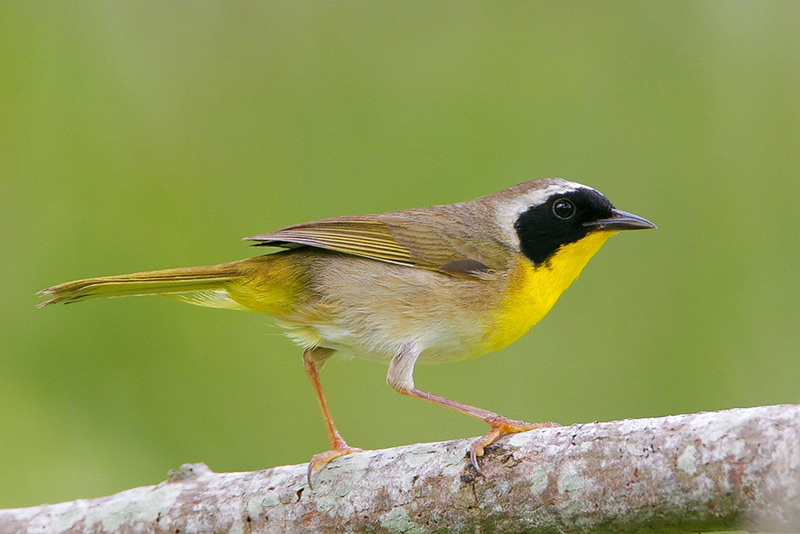
Photograph © Greg Lavaty.
The Common Yellowthroat is a warbler of marshes and dense, wet second growth. The male has a striking black mask partly bordered with silvery-gray, a lemon yellow throat and breast, white belly, and olive-brown upperparts.
Females and young Common Yellowthroats may have a hint of a mask or a plain face with a pale eyering, and pink-gray bill. They also have rather rounded wings, a medium length, rounded tail, and pink legs and feet.
The small Common Yellowthroat forages for a variety of small insects in wet, grassy habitats at the edges of ponds, lakes, forest, and in marshes. It usually picks insects from the ground and low vegetation and is a common summer species in many parts of Massachusetts.
Its “whichety-witchety-witchety” song is often heard but the bird leaves the state in fall to migrate to areas in the southern states south to Central America.
Blue Jay
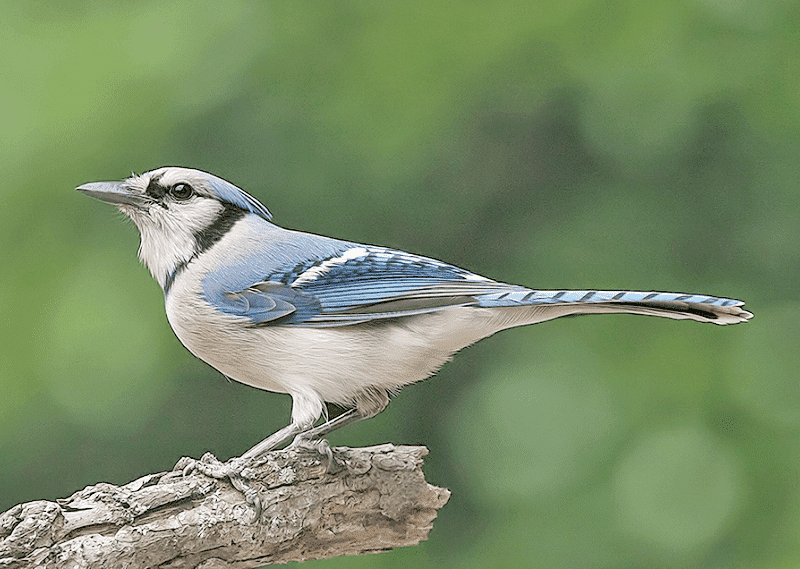
Photograph © Alan Wilson.
The Blue Jay is one of the more striking birds of Massachusetts. This beautiful jay species is a fairly large yet slender bird with a crest, stout and strong black beak, and grayish blue on the crest and back.
It has brighter blue in the wings and tail, a white face and throat with a black line through the eye, and a black line at the back of the face, in front of the bill, and bordering the throat.
Male and female birds look the same and have black banding and white marks on rounded wings and a long tail. The rest of the underparts are pale and white gray.
The Blue Jay eats a variety of nuts, acorns, seeds, and large insects such as cicadas and dragonflies. Like their crow relatives, Blue Jays will also eat carrion, nestlings, bird eggs, and other small animals they manage to catch.
They can sally for insects and use their beaks to pick food from the ground, foliage, and eat seed at feeders. These social birds form small flocks and have many calls, one of which is the frequently given, “Jee-er! Jee-er!”.
House Wren
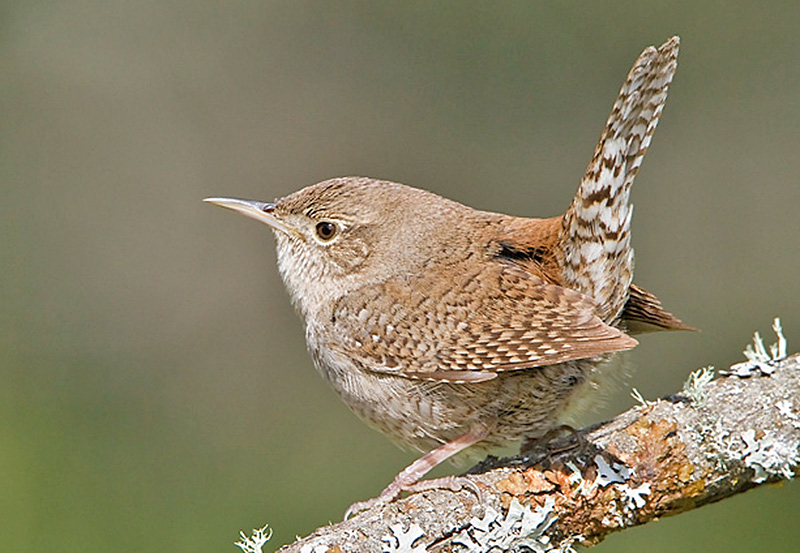
Photograph © Glenn Bartley.
The House Wren is a small, plain bird with gray-brown plumage, a pale throat, and a pale, sharp, slightly curved beak. Both sexes look the same, and young birds resemble adults but can be a bit more colorful.
This small, animated species has a dark line going back from the eyes, a bit of an eyering, black banding on the lower back, reddish-brown tail, brown wings, and pale undertail. The House Wrens has short and rounded wings, and a medium, rounded tail often held at a cocked-up angle.
House Wrens eat small bugs, spiders, caterpillars, and other insects. They are usually seen creeping around wood piles and other spots on or near the ground where they use their beaks to snatch food from twigs, leaves, the ground, bark, and other places where insects and spiders like to hide.
House Wrens are also usually seen in pairs and are a regular feature in second-growth, parks, gardens, and other habitats with vegetation and tree cavities for nesting.
Pine Warbler
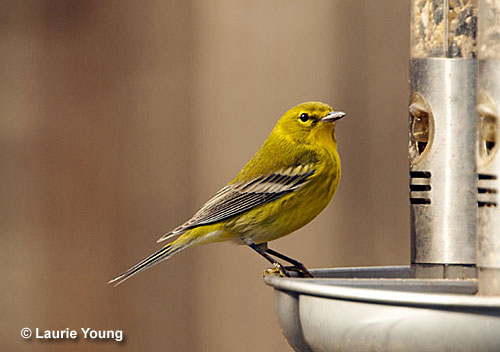
Pine Warbler
The Pine Warbler is a yellowish and olive warbler with a small dark bill, yellow on the face, throat, and breast, and white on the belly and under the tail. It has a narrow, broken eyering, olive on the head, back, and rump, and some olive streaking on the underparts.
The longish wings are dark gray with two white bars, and the tail is dark gray. Females resemble males but are duller overall. Juvenile birds can be duller still with very little or no yellow.
True to its name, the Pine Warbler is a coniferous forest bird. This species is so tied to evergreens it is rarely found in other types of forest, although it can forage in deciduous trees during migration and winter.
It forages for caterpillars and small insects by picking them from pine needles, branches, and other foliage, often, high above the ground. The short trill of this common species is often heard in coniferous forests in Massachusetts but, by fall, most leave the state to winter in the southeastern USA.
Cedar Waxwing
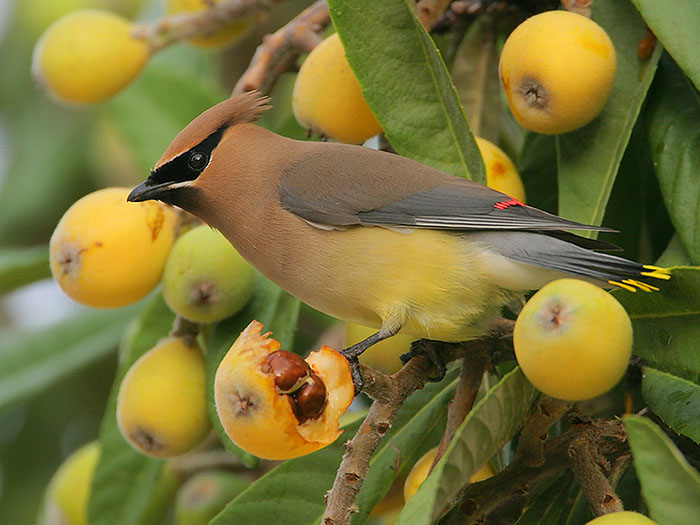
The Cedar Waxwing is a thrush-sized, crested bird with soft, mauve and brown hues, and a narrow black mask.
Male and female waxwings look the same and also have gray on the back and wings, pale yellow on the belly, a dark gray tail with a bright yellow tip, and a few tiny red spheres on part of their wings. Young waxwings resemble adults but have streaks in grayer plumage.
This beautiful bird eats a combination of berries, small fruit, and insects. In summer, waxwings forage for insects by sallying for them from bushes and trees.
In all seasons, but especially in winter, they feast on berries, crabapples, and other fruits that they select with their bills while perched. Cedar Waxwings are very social birds rarely seen on their own.
They can form large flocks and are frequent in parks, big gardens, and woodlands in Massachusetts. Listen for the high-pitched whispering vocalizations of this beautiful bird in these and other habitats in the state.
Yellow Warbler
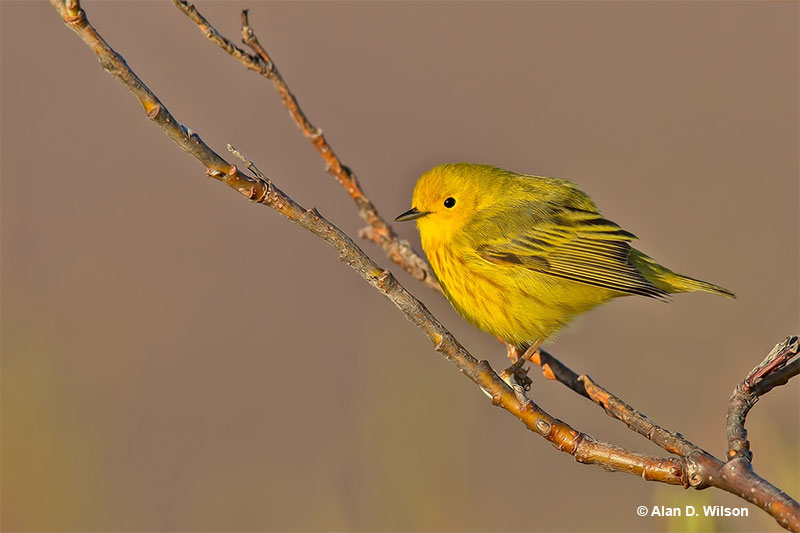
© Alan D. Wilson
The Yellow Warbler is a small, mostly yellow bird with a slender, dark beak. Male Yellow Warblers in breeding plumage are entirely bright yellow with some black edging in their wings, and rufous streaks on the breast.
Females and juvenile Yellow Warblers look similar but are duller yellow and lack the rufous streaks. They can be tricky to identify from other warbler species but can always be told by the yellow spots in their tails.
Yellow Warblers are one of the more common birds of Massachusetts and breed in second-growth and forest-edge habitats throughout the state. They forage for small insects by picking them from vegetation, often in bushes and low trees, and also sally to catch bugs in the air.
The sweet sounding “sweet sweeter than sweet!” song is the sound of June in many parts of Massachusetts. In fall, this pretty little bird migrates to the Caribbean and sites further south for the winter.
Hawks in Massachusetts
Red-tailed Hawk
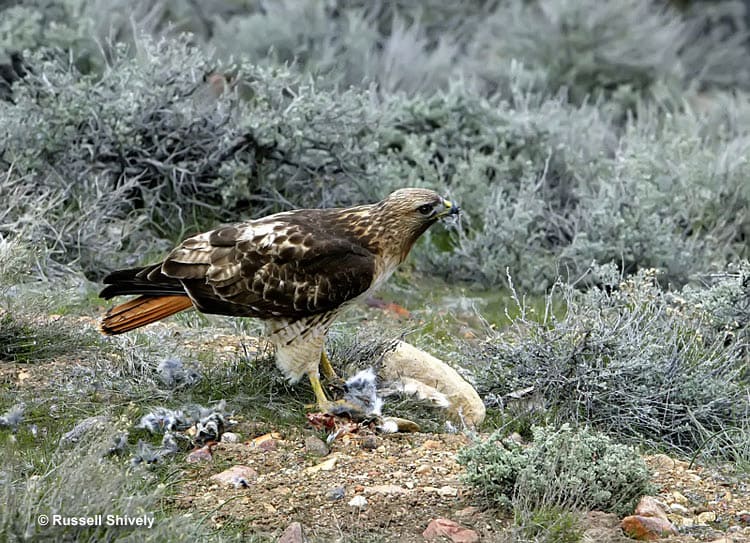
The Red-tailed Hawk is the most common and frequently seen of the hawks in Massachusetts. A big and stocky hawk, adults are mottled brown above and white below with dark brown markings that form a “belly band.”
They have a reddish tail and also have long, broad wings with a square, pale patch at the base of the primaries. Juvenile Red-tailed Hawks look like adults but have a brown, barred tails.
As with other raptors, females are larger than males but this can be hard to tell in the field.
The Red-tailed Hawk feeds on squirrels, rats, snakes, and many other small animals in a wide variety of habitats. In some places, these hawks live in cities but are more common in rural areas.
They forage by flying high into the sky or perch on a branch and keep watch until they spot prey. The hawk then swoops down to snatch the animal with its talons.
Broad-winged Hawk
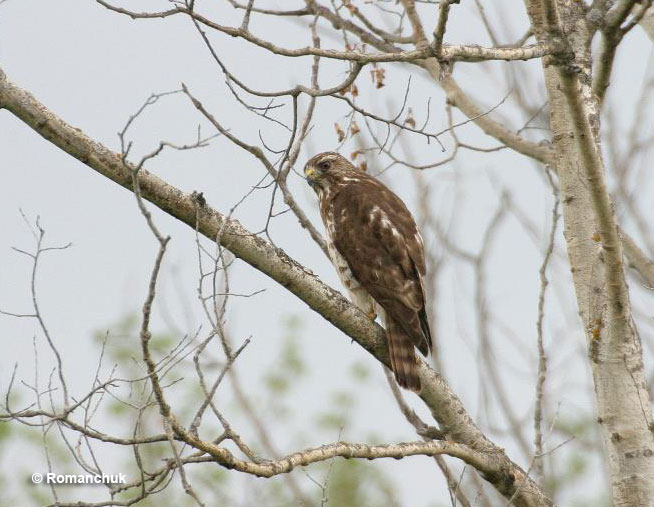
Broad-winged Hawk
The Broad-winged Hawk is one of the smaller hawks in Massachusetts. Around the size of a small crow, Broad-winged Hawks are dark brown above with some pale markings and pale below with reddish-brown barring on the underparts.
They also have a dark mark at the edge of each side of the throat and prominent white bands on a dark, broad tail. Young hawks look similar but have streaks below instead of barring and less pronounced bands on the tail.
This species lives in woodlands with some clearings, especially bogs and other spots with wet areas that attract its favorite food; frogs, small mammals, and insects. It can also take nestling birds and the occasional small snake. No matter what the prey item is, this hawk catches it with talons after dropping down onto the animal from a perch.
This common hawk is often seen soaring above woodlands in Massachusetts and migrates to tropical regions for the winter.
Cooper’s Hawk
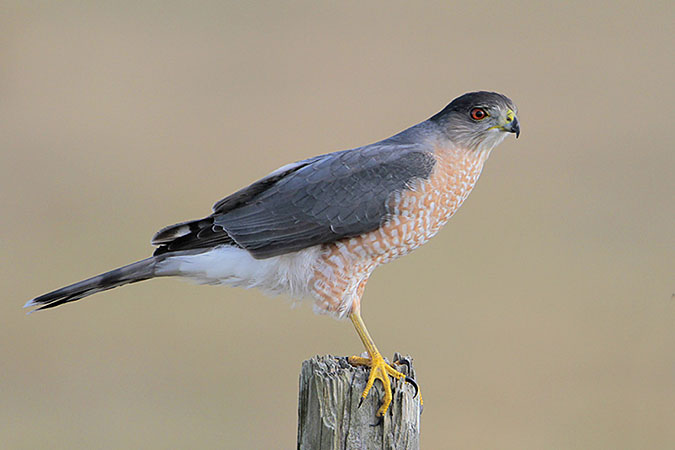
The Cooper’s Hawk is a powerful, fairly large hawk with a squared head and a long tail with a rounded tip. Adults have slate-blue upper parts, reddish barring on pale underparts, red eyes, often have a dark gray cap, and some dark bands on the tail.
Young birds are shaped like adults but have brown streaks on pale underparts and are brown above with some mottling. This hawk species flies with a few quick, deep flaps followed by briefly soaring.
The Cooper’s Hawk uses its medium-length, rounded wings and its long tail to help it maneuver and zip between trees and bushes when hunting doves, woodpeckers, pigeons, rabbits, and other small animals. It catches prey with its long legs and talons and is a frequent visitor to feeders where it stalks the birds that eat the birdseed!
In Massachusetts, the Cooper’s Hawk occurs in woodlands and many urban and suburban areas throughout the state.
Red-shouldered Hawk
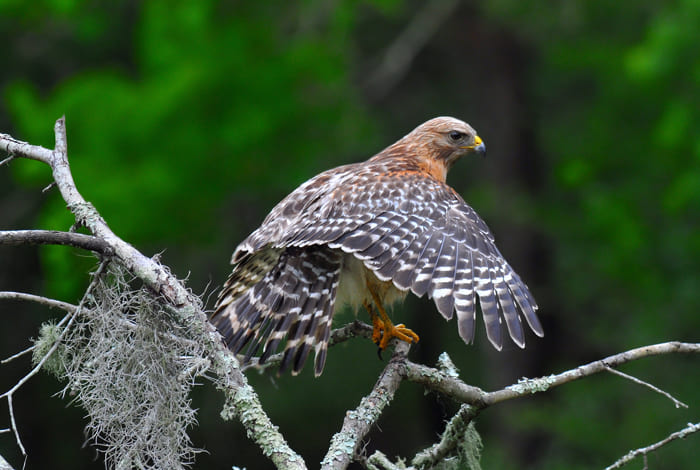
The Red-shouldered Hawk is a pretty, medium-sized hawk with long, broad wings and a longish tail.
Adults have a russet orange breast and barring on the underparts, russet with dark streaks on the head and upper back, a pale throat bordered with a dark on each side, and blackish wings with reddish shoulders and white markings. The tail is also blackish with white bands. Juveniles are similar to adults but are browner overall.
All ages can be identified in flight by the white bands in a longish tail, and a distinctive pale crescent at the base of the primaries.
The Red-shouldered Hawk feeds on chipmunks, voles, snakes, frogs, and other small animals caught with its talons after dropping down onto them from a perch.
It lives in a variety of forested areas and, in Massachusetts, can often be heard giving its loud, jay-like calls and seen soaring above forest, especially near wetlands and lakes.
Sharp-shinned Hawk
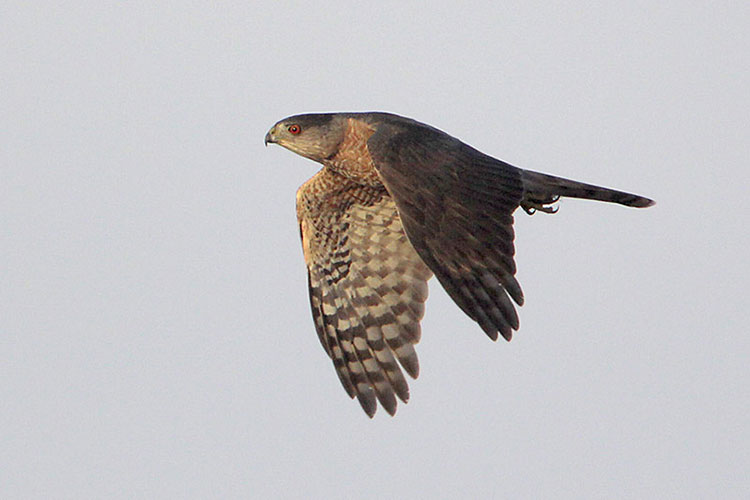
Sharp-shinned Hawk
The Sharp-shinned Hawk is the smallest of the hawks in Massachusetts. They can be similar in size to a Blue Jay or a dove, have short, rounded wings, and a long, rectangular tail with dark bands.
Adult Sharp-shinned Hawks are slate-gray above, have red eyes, and reddish-orange barring on the underparts, whereas young birds are mottled brown above and have brown streaks on pale underparts.
Overall, Sharp-shinned Hawks are very similar to Cooper’s Hawks but are smaller, have more rounded heads, thinner legs, and rectangular tails.
This species relies on small birds for food. It eats warblers, vireos, chickadees, Northern Cardinals, and any other small bird it can manage to catch and kill with its sharp talon. The Sharp-shinned Hawk forages by hiding in dense vegetation and then quickly flying out to catch an unwary bird by surprise.
Keep reading: Full list of hawks you can see in Massachusetts
In Massachusetts, this species lives in coniferous woodlands and other habitats throughout the state and can visit feeders to hunt birds.
Owls in Massachusetts
Barred Owl
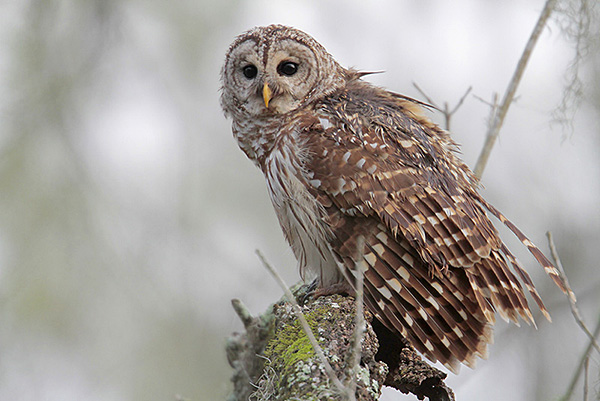
Photograph © Greg Lavaty.
The Barred Owl is a large owl with a rounded head, dark brown eyes on a pale face with a dark border, and brown upperparts with white markings. It has pale underparts with dark brown streaks, long, rounded wings, and a broad tail with dark bands.
Male and female birds are similar although, as with most raptors, females are a bit larger. The Barred Owl also has a narrow, sharp yellow beak.
Barred Owls feed on small mammals, crayfish, and other small animals. It is not a picky eater and will also take insects and birds up to the size of a Ruffed Grouse.
This big owl catches food by listening and looking from a perch at night and then swooping down to catch the animal with its talons. The Barred Owl occurs in a variety of wooded habitats and its distinctive “Who cooks for you?” calls can be heard in many parts of Massachusetts.
Eastern Screech-Owl
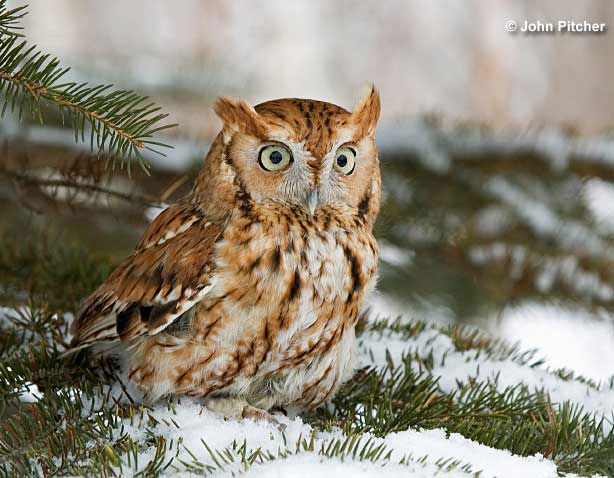
The Eastern Screech-Owl is a small, pint-sized owl with prominent “ear tufts” and mottled plumage that acts as excellent camouflage during the day.
It can be mostly gray with some white spotting in the wings, dark mottling above, and streaks and some barring on pale underparts, or reddish with a similar pattern. Both sexes look the same, have yellow eyes, and fairly long, rounded wings.
This owl species feeds on a wide variety of small animals including mice, voles, insects, and small birds. It catches them by watching and listening from a perch at night, and then swooping down to catch the animal with its talons.
Many of these small owls in Massachusetts live in parks and woodlands but are easily overlooked. When we listen for their tremulous vocalization, we realize how common this small owl really is.
Great Horned Owl

The Great Horned Owl is a large nocturnal raptor with a bulky body, “ear tufts”, and a narrow white patch between the throat and breast. It has a rufous face bordered with black, a sharp black bill, staring yellow eyes, and narrow dark banding on brownish underparts.
The upper parts are mottled brown, and it has long, mottled brown wings, and a broad, brown or gray tail with some black bands. Both sexes look the same, although females are larger.
This powerful owl feeds on pretty much anything it feels like catching. That includes birds as small as Yellow Warblers, mice, rats, skunks, rabbits, the young of other raptors like the Red-tailed Hawk, and other animals.
It forages at night by watching from a perch and then flying down to catch and kill the animal with its sharp talons and strong grip. In Massachusetts, this owl is common and occurs in every type of habitat, even in cities.
Snowy Owl
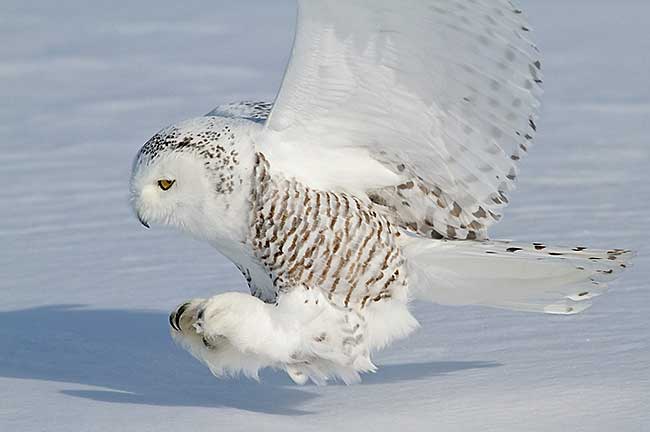
The Snowy Owl is a large, breathtaking white owl with a rounded head, long, broad wings, and yellow eyes.
Adult males can be entirely white, while females and young birds are white with small black and wavy markings on the underparts, back, wings, and head.
This stunning owl species from the Arctic is unmistakable and, even better, is active during the day!
This spectacular owl species feeds on rats, ducks, and many other small and medium-sized animals and birds in wide open habitats similar to its tundra breeding grounds.
It forages by sitting on a haystack, telephone pole, or other perch and then flying out to catch prey with its talons. It also often perches on the ground where it can be easily mistaken for a plastic bag (or vice-versa).
In Massachusetts, this magnificent owl is a regular winter visitor to airports, coastal sites, and other open areas.
Northern Hawk Owl
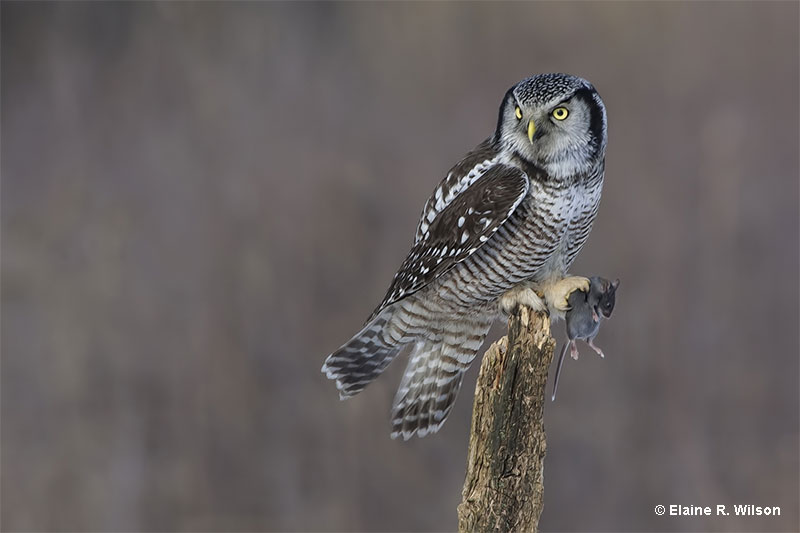
© Elaine R. Wilson
The Northern Hawk Owl is a medium-sized, slender owl active during the day. This distinctive owl species has a square-shaped head with black and white mottling on the crown and a pale face with a thick black border. It also has a white mark bordered with black on each side of the head, yellow eyes, and a narrow yellow bill.
The underparts are white with fine, dark barring, and the upperparts dark brown with white spotting. This owl species also has long, rounded wings and a long dark brown tail with some white bands.
This dirunal owl feeds on voles and other small mammals and can also catch grouse and other birds. It forages by watching from a high perch, often, the tip of a conifer, and then swooping down and gliding low over the ground to surprise and snatch the prey item with its talons.
In Massachusetts, the Northern Hawk Owl is a rare winter resident in semi-open, wooded areas. Fortunately, like the Snowy Owl, its diurnal behavior makes it easier to find than other owl species.
Keep reading: Owl species in Massachusetts
Frequently Asked Questions about the Birds Of Massachusetts
How many bird species are native to Massachusetts?
510 species are on the birds of Massachusetts list.
What is the most common bird in Massachusetts?
The Black-capped Chickadee is one of the most common birds in Massachusetts. Other common birds include the American Robin, Ring-billed Gull, and the House Sparrow.
What is a medium gray bird in Massachusetts?
The Black-capped Chickadee, Blue-gray Gnatcatcher and Tufted Titmouse are three medium gray birds commonly seen in Massachusetts.
What is the dark gray bird in Massachusetts?
The Gray Catbird is a dark gray bird often seen in Massachusetts during the summer months.
What is the yellow small bird in Massachusetts??
The Yellow Warbler and American Goldfinch are two of the most common yellow, small birds that live in Massachusetts.
What is the bright blue bird in Massachusetts?
The male Indigo Bunting is a small, bright blue bird that lives in Massachusetts.

